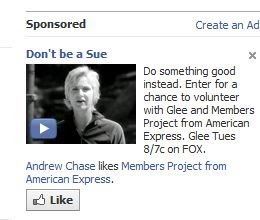Case study: American Express Members Project
What kind of marketing works when there is no substantive customer service issue as the mainstay content king, like Home Depot's big bet? That's the question when it comes to participation marketing, isn't it, Todd Defren?
I should state that I think Todd is brilliant in his conclusions that things need to be both sexy and long-term (sounds a lot like what most marriages need) but I'm not so sure participation marketing is as clear to strategize when it comes to a business that has less apparent customer service content to broadcast and share.
Does that mean we must cultivate a customer service "awareness" campaign to tell consumer we care? Or does that mean we find other ways of showing we care? And then ask consumers if they, too, care.
I think it's a combination of all of the above, plus each case must be examined on it's own merits when it comes to fully integrating social media as part of a larger campaign.
Here is an example of an organization fully integrating their corporate endeavors with their social media strategy; also a good use of a celebrity endorsement.
To the consumer, it starts as a FB ad with some compelling copy --- "Don't Be A Sue." and attached to a trending topic: Glee. Or in some cases, it starts as a TV viewer of Glee searches online for Glee assets and gets pointed to the Members Project Facebook site (that also offers a Glee tab). Any way the consumer reaches the destination is the same; the multichannel seeding is robust and therefore, succesful.
In the case of the FB ad, the video pops up in a frame right there on Facebook and delivers some quiky, funny humor with a call to philanthropic action; driving to a fully built-out Facebook site.
The site offers 27 other compelling video's, areas of engagement for users, a tab for fans of Glee and more; all with the goal of promoting their contest to donate $1m to charity; and thus promoting their brand quite nicely.
The site has 341,627 fans. American Express has 80,566 fans and Glee has over 8,000,000 fans, so clearly there is plenty of room for growth. (In my own circle of FB friends, 14 are fans of Glee. Wow. Must mean I have a lot of twisted, sarcastic, trendy friends. Yay!) But more than that, people are showing signs of correlating content to content...they enjoy Glee, they enjoy (or dispise) Sue, Sue promotes AE Members Project...they become engaged with AE Members Project...they think positively about AE.)
Of course, there is data I don't have: how much money was spent in budget for marketing this campaign compared to overall marketing of AE, GLee, and the Members Project - and how this activity impacts the financials of AE or even the public perception of the brand. But the idea here is that there is an equation worth investigating when it comes to baking a successful social media strategy for a large corporation; use your existing partnerships...pithy up your areas of opportunity to build the strongest campaigns and add into those campaigns these ingredients:
1. compelling content (unique, emotional, funny, slightly offensive, very funny, with kids, causes, puppies or superstar & celebrities)
2. a reason (contest, sweepstakes, prize, voting, etc.) to engage, share, comment, forward, reply
3. a concentrated brand...a robust experience...a strong following (users can tell when campaigns are low budget, slapped together last minute or not a real area of interest for the enterprise...if the company doesn't care, why should the consumer?)
It's interesting to note that for the last two years, American Express has been listed as 22, 24 for the years 2009, 2010 respectively, on Interbrand's Best Global Brands. Read an interview with Alison Bain, their head of International Advertising. Good stuff.
Anyone have insight into how much American Express commits to Members Project each year? Or how much they pay for their partnership with Glee? That would be good stuff to know, too.
I should state that I think Todd is brilliant in his conclusions that things need to be both sexy and long-term (sounds a lot like what most marriages need) but I'm not so sure participation marketing is as clear to strategize when it comes to a business that has less apparent customer service content to broadcast and share.
Does that mean we must cultivate a customer service "awareness" campaign to tell consumer we care? Or does that mean we find other ways of showing we care? And then ask consumers if they, too, care.
I think it's a combination of all of the above, plus each case must be examined on it's own merits when it comes to fully integrating social media as part of a larger campaign.
Here is an example of an organization fully integrating their corporate endeavors with their social media strategy; also a good use of a celebrity endorsement.
To the consumer, it starts as a FB ad with some compelling copy --- "Don't Be A Sue." and attached to a trending topic: Glee. Or in some cases, it starts as a TV viewer of Glee searches online for Glee assets and gets pointed to the Members Project Facebook site (that also offers a Glee tab). Any way the consumer reaches the destination is the same; the multichannel seeding is robust and therefore, succesful.
In the case of the FB ad, the video pops up in a frame right there on Facebook and delivers some quiky, funny humor with a call to philanthropic action; driving to a fully built-out Facebook site.
The site offers 27 other compelling video's, areas of engagement for users, a tab for fans of Glee and more; all with the goal of promoting their contest to donate $1m to charity; and thus promoting their brand quite nicely.
The site has 341,627 fans. American Express has 80,566 fans and Glee has over 8,000,000 fans, so clearly there is plenty of room for growth. (In my own circle of FB friends, 14 are fans of Glee. Wow. Must mean I have a lot of twisted, sarcastic, trendy friends. Yay!) But more than that, people are showing signs of correlating content to content...they enjoy Glee, they enjoy (or dispise) Sue, Sue promotes AE Members Project...they become engaged with AE Members Project...they think positively about AE.)
Of course, there is data I don't have: how much money was spent in budget for marketing this campaign compared to overall marketing of AE, GLee, and the Members Project - and how this activity impacts the financials of AE or even the public perception of the brand. But the idea here is that there is an equation worth investigating when it comes to baking a successful social media strategy for a large corporation; use your existing partnerships...pithy up your areas of opportunity to build the strongest campaigns and add into those campaigns these ingredients:
1. compelling content (unique, emotional, funny, slightly offensive, very funny, with kids, causes, puppies or superstar & celebrities)
2. a reason (contest, sweepstakes, prize, voting, etc.) to engage, share, comment, forward, reply
3. a concentrated brand...a robust experience...a strong following (users can tell when campaigns are low budget, slapped together last minute or not a real area of interest for the enterprise...if the company doesn't care, why should the consumer?)
It's interesting to note that for the last two years, American Express has been listed as 22, 24 for the years 2009, 2010 respectively, on Interbrand's Best Global Brands. Read an interview with Alison Bain, their head of International Advertising. Good stuff.
Anyone have insight into how much American Express commits to Members Project each year? Or how much they pay for their partnership with Glee? That would be good stuff to know, too.


Comments
Post a Comment